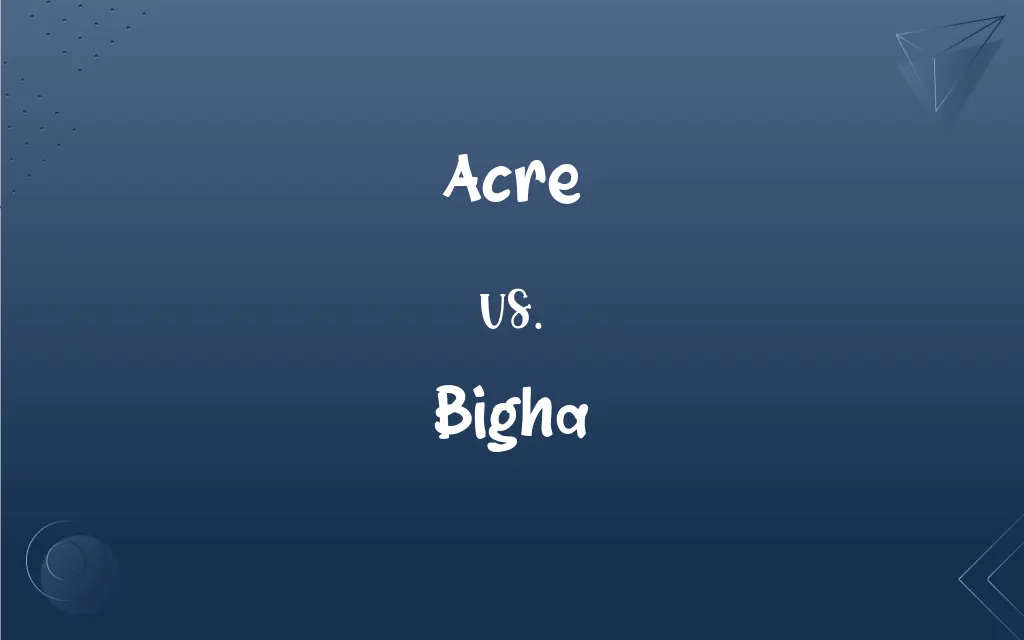Acre vs. Bigha: What's the Difference?
Edited by Aimie Carlson || By Janet White || Updated on September 28, 2023
An acre is a unit of area in the imperial and U.S. customary systems, equal to 4,840 square yards, while a bigha is a varying traditional unit of area used in the Indian subcontinent, its size varying regionally.

Key Differences
An acre is a unit of measurement primarily used to measure land area, commonly used in the United States and other countries using the imperial system. It is a standardized unit, globally recognized and equivalent to 4,840 square yards or 43,560 square feet. Conversely, a bigha is a traditional unit of area measurement used in various regions of the Indian subcontinent, like India, Nepal, and Bangladesh. The bigha's size is not standardized and varies significantly between different regions, leading to differences in the area it represents.
The acre is widely used in international science and is a U.S. customary unit, making it a common unit of measurement in the United States for land and agricultural plots. It provides a universal value and is used in legal documents, scientific research, and land deals. On the other hand, bigha, with its variability, is often localized to specific regions within the Indian subcontinent. It is deeply entrenched in local agrarian cultures and is a customary unit for land transactions and agricultural measurements in those areas.
When comparing these two units of measurement, the significant disparity is the standardization and uniformity of the acre versus the variability of the bigha. The acre provides a uniform measurement, making it universally recognized and understood, while the bigha's lack of standardization necessitates clarification and conversion based on the regional variant being used. Despite this, both units are crucial in their respective regions, aiding in land assessment, agricultural planning, and real estate transactions.
While the acre is extensively recognized and employed in international and scientific communities due to its standardization, the bigha remains essential due to its cultural relevance and widespread use in regional agrarian societies within the Indian subcontinent. The conversion between an acre and a bigha can be complex and necessitates precise regional understanding due to the variability in the size of a bigha in different areas.
Comparison Chart
Standardization
Standardized globally
Varies regionally
ADVERTISEMENT
Use
Globally in imperial system
Indian subcontinent
Size
4,840 square yards
Varies, e.g., In India, ranges from 1,500 to 6,771 square meters
Recognition
Internationally recognized unit
Locally recognized unit
Application
Land, agricultural plots
Land, especially agricultural in specific regions
Acre and Bigha Definitions
Acre
A U.S. customary unit used in land and agricultural measurements.
They bought a 50-acre farm in the countryside.
ADVERTISEMENT
Bigha
A non-standardized unit entrenched in local agrarian cultures.
Agricultural yields are often measured per bigha in rural areas.
Acre
A measure used internationally in scientific research and legal documents for land area.
The new residential project will span across 100 acres.
Bigha
A customary unit used for land transactions and agricultural measurements in specific areas.
He bought 2 bighas of land for farming in the village.
Acre
A unit of area measurement equivalent to 4,840 square yards.
The park covers an area of 20 acres.
Bigha
A varying unit often localized to specific regions within countries like India, Nepal, and Bangladesh.
A bigha in Bihar is different in size from a bigha in West Bengal.
Acre
A widely recognized unit for assessing land value and size in real estate.
The estate is valued based on its 30-acre land size.
Bigha
A traditional unit of area used predominantly in the Indian subcontinent.
The farmer owns a piece of land measuring 5 bighas.
Acre
A unit of area in the US Customary System, used in land and sea floor measurement and equal to 160 square rods, 4,840 square yards, or 43,560 square feet. See Table at measurement.
Bigha
A regionally significant unit of measurement that aids in land assessment and planning.
The community land is about 3 bighas in area.
Acre
Acres Property in the form of land; estate.
Bigha
(India) A measure of land in India, varying from a third of an acre to an acre.
Acre
(Archaic) A field or plot of arable land.
Bigha
A measure of land in India, varying from a third of an acre to an acre.
Acre
Often acres A wide expanse, as of land or other matter
"acres of textureless carpeting" (Anne Tyler).
Acre
An English unit of land area (symbol: a. or ac.) originally denoting a day's ploughing for a yoke of oxen, now standardized as 4,840 square yards or 4,046.86 square meters.
Acre
An area of 10,240 square yards or 4 quarters.
Acre
Any of various similar units of area in other systems.
Acre
A wide expanse.
I like my new house - there’s acres of space!
Acre
A large quantity.
Acre
(obsolete) A field.
Acre
(obsolete) The acre's breadth by the length, English units of length equal to the statute dimensions of the acre: 22 yds (≈20 m) by 220 yds (≈200 m).
Acre
(obsolete) A duel fought between individual Scots and Englishmen in the borderlands.
Acre
Any field of arable or pasture land.
Acre
A piece of land, containing 160 square rods, or 4,840 square yards, or 43,560 square feet. This is the English statute acre. That of the United States is the same. The Scotch acre was about 1.26 of the English, and the Irish 1.62 of the English.
I like that ancient Saxon phrase, which callsThe burial ground, God's acre.
Acre
A unit of area (4840 square yards) used in English-speaking countries
Acre
A territory of western Brazil bordering on Bolivia and Peru
Acre
A town and port in northwestern Israel in the eastern Mediterranean
Acre
A standardized unit in the imperial system for measuring large plots of land.
The forest reserve is thousands of acres in size.
FAQs
Is an acre a standardized unit of measurement?
Yes, an acre is a standardized unit, equal to 4,840 square yards.
Can an acre be used in scientific research?
Yes, an acre is used in scientific research due to its standardized measurement.
Is bigha used outside the Indian subcontinent?
Generally, no, bigha is predominantly used in the Indian subcontinent.
Is an acre used globally?
Yes, an acre is used globally, especially in countries using the imperial system.
Does the size of a bigha vary?
Yes, the size of a bigha varies significantly between different regions.
How many square yards are in an acre?
An acre contains 4,840 square yards.
Is an acre a legal unit of measurement for land deals?
Yes, an acre is a legal and recognized unit for land deals and is used in legal documents.
Is bigha used in urban land measurement?
Typically, bigha is more commonly used in rural land measurement, but it can also be used in urban areas.
Are there any similar units to bigha in other countries?
Yes, different countries have their traditional and local units of land measurement.
Can the value of a bigha be different in India and Nepal?
Yes, the value of a bigha can differ between India and Nepal due to regional variations.
Is an acre used for measuring agricultural land?
Yes, an acre is commonly used for measuring agricultural land.
Is bigha a traditional or a modern unit of measurement?
Bigha is a traditional unit of measurement.
Is bigha recognized in legal documents?
Yes, bigha is recognized in legal documents, especially in regions where it is customarily used.
Can an acre be subdivided into smaller units?
Yes, an acre can be subdivided into smaller units like square yards and square feet.
Can the value of an acre vary?
No, the value of an acre is standardized and does not vary.
About Author
Written by
Janet WhiteJanet White has been an esteemed writer and blogger for Difference Wiki. Holding a Master's degree in Science and Medical Journalism from the prestigious Boston University, she has consistently demonstrated her expertise and passion for her field. When she's not immersed in her work, Janet relishes her time exercising, delving into a good book, and cherishing moments with friends and family.
Edited by
Aimie CarlsonAimie Carlson, holding a master's degree in English literature, is a fervent English language enthusiast. She lends her writing talents to Difference Wiki, a prominent website that specializes in comparisons, offering readers insightful analyses that both captivate and inform.































































